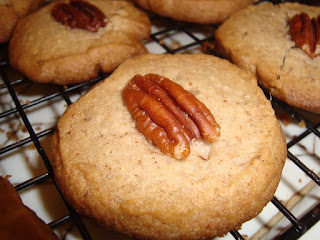
Ingredients
1 1/2 cups pecan halves, plus about 32 pecan halves for pressing onto unbaked cookies
1/4 cup confectioner's sugar
1/2 cup packed light brown sugar
1 1/2 cups unbleached all-purpose flour
1/4 teaspoon salt
12 tablespoons (1 1/2 sticks) cold unsalted butter cut into 1/2 inch cubes
1 large egg yolk
Instructions
1) In a food processor, process 1 1/2 cups pecans with both sugars until nuts are ground, about twenty 1 second pulses. Add the flour and salt and process to combine, about twelve 1 second pulses. Scatter the butter pieces over the dry ingredients and process until the mixture resembles damp sand and rides up the sides of the bowl, about eighteen 1 second pulses. With the machine running, add the yolk and process until the dough comes together into a rough ball, about 20 seconds.
2. Turn the dough (it will look scrappy and uneven) onto a clean, dry work surface and gently knead until it is evenly moistened and cohesive. Using the palms of your hands, roll the dough into an even 12-inch log, cut the log in half with a chef's knife, and wrap each half in plastic wrap. Freeze the dough logs until very cold but still malleable, about 30 minutes. Remove them from the freezer, unwrap them, and toll them on the work surface to round off the flat sides. Rewrap the logs in plastic wrap and refrigerate them until thoroughly chilled and completely firm, about 2 hours.
3. Adjust the oven racks to the upper- and lower-middle positions and heat the oven to 325 degrees. Line 2 large baking sheets with parchment paper or spray them with nonstick cooking spray. Unwrap the dough logs and using a sharp chef's knife, slice the logs into coins 1/4 inch thick, slightly rotating the logs after each slice so that they do not develop a markedly flat slide. Place t slices on the prepared baking sheets, spacing them about 3/4 inch apart. Press a pecan half in the center of each slice.
4. Bake until the edges of the cookies are golden brown, about 24 minutes, rotating the baking sheets front to back and top to bottom halfway through the baking time. Cool the cookies 3 minutes on the baking sheets, then transfer them to a wire rack with a wide metal spatula and let cool to room temperature.
People have made some comments to me that I always make mistakes while baking. This isn't necessarily true...but I am very open and honest with you guys about things I could do to improve in both efficiency of the recipe and taste. I love finding ways to improve myself and my baking. So if you have any comments on the above things, please let me know. This being said....I will begin my critique of this recipe.
The recipe calls for basically the whole recipe to be made in the food processor. Now, I love my new food processor/baby but it wasn't big enough to hold all of the dough for the recipe. I discovered this as I made the recipe. I had to take out dough and place it in a separate bowl and mix the remaining dough in the food processor. Then, I exchanged the unmixed dough for mixed dough in the processor and repeated the process until everything was mixed. If I had not had trouble with the size of my food processor, the dough would have actually been created within 10 minutes... yes the recipe is that easy!
Overall, I give these cookies 4 out of 5 stars. You have to like shortbread to like these cookies but they turned out quite good. Not too sweet, not to crisp. They crumble in your fingers as you eat them, but melt in your mouth. I will definitely make them again.































